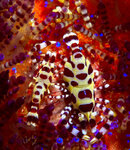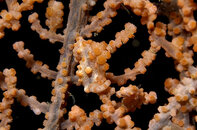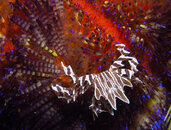peterjmaerz
Guest
Hello Wet Ones,
Here's my report on a fantastic trip aboard the SMY Ondina:
The trip was one of two in the area organized every year by Deb Fuggitt out of Texas, one of the first to fully recognize the value of this amazing area to divers. Deb's a fantastic photographer and organizes her trips around that pursuit. She also happens to be an amazingly dedicated trip organizer; for the better part of a year, we exchanged emails at least once a week, often times in flurries, as the shifting tides of Indonesian trip planning affected ours. Rarely did I have to wait more than a few minutes for a reply to an email. Deb managed to keep abreast of every one of her 12 passengers' complex travel plans and guide us every step of the way.
Travel to Asia is, well, travel to Asia, especially if you place yourself at the mercy of an airlines Frequent Flier program. Countless hours in airborne limbo. I took advantage of a couple of lengthy layovers, though, and managed to spend a full day in Seoul touring palaces and a good number of hours comfortably asleep in a free travel lounge in the amazing Singapore transit terminals. I also heartily recommend Korean Airlines; they're a real throwback- from 1950's style "stewardess" uniforms (and, forgive me, knockout women obviously chosen for their appearance as well as their safety other skills) to tending to your every whim, to providing very reasonable legroom, even in coach, these folks aim to please.
I spent a part of two days and a night in a jungle reserve some hours outside of Manado, called Tangkoko. It's worth the trip if you have time enough (but not enough time to dive in the area). The tiny, huge-eyed Tarsier monkeys that pop out of tree knots at dusk are a sight to behold. But they pale in comparison to the throngs of apes that congregate at dawn. They seem fairly oblivious to human presence. One sidled up to me and, while locking his eyes on mine, proceeded to gently gnaw on my shoulder. Flocks of the monkeys ripped through the trees, shredding leaves as they swung from branch to branch in wild play. Others lay in knots on the dusty ground, grooming each other.
Members of our liveaboard party gathered at 1 in the morning in the splenderous, if worn-around-the-edges lobby of Manado's wonderfully named "Ritzy Hotel" for a surreal, full course breakfast in the otherwise deserted, palatial restaurant area adjacent to the lobby. Soon after, we were met in the lobby by three micro vans for our trip back to the airport. Once there, we were assisted through checkin (and modest luggage overage bribes--uh, I mean charges--)
by Deb's trip organizers.
After a short, two hour flight to Sorong, we were met at the airport by Deb, her partner Tony and other members of hers and the Ondina's crew. We drove through the oily, decrepit streets of this backwater town to the concrete docks at the edge of a greasy bay, studded with rusting, half-submerged hulks, as well as a handful of the "Pinsi" schooners that carry divers to paradise. As laconic, sullen onlookers gazed steely eyed from their perches on crumbling benches, we shiny clean westerners and our enormous loads of luggage were taken from van to "tinnie" (Dinghy) and then whisked across the dawn-streaked water to the mother ship.
Here's my report on a fantastic trip aboard the SMY Ondina:
The trip was one of two in the area organized every year by Deb Fuggitt out of Texas, one of the first to fully recognize the value of this amazing area to divers. Deb's a fantastic photographer and organizes her trips around that pursuit. She also happens to be an amazingly dedicated trip organizer; for the better part of a year, we exchanged emails at least once a week, often times in flurries, as the shifting tides of Indonesian trip planning affected ours. Rarely did I have to wait more than a few minutes for a reply to an email. Deb managed to keep abreast of every one of her 12 passengers' complex travel plans and guide us every step of the way.
Travel to Asia is, well, travel to Asia, especially if you place yourself at the mercy of an airlines Frequent Flier program. Countless hours in airborne limbo. I took advantage of a couple of lengthy layovers, though, and managed to spend a full day in Seoul touring palaces and a good number of hours comfortably asleep in a free travel lounge in the amazing Singapore transit terminals. I also heartily recommend Korean Airlines; they're a real throwback- from 1950's style "stewardess" uniforms (and, forgive me, knockout women obviously chosen for their appearance as well as their safety other skills) to tending to your every whim, to providing very reasonable legroom, even in coach, these folks aim to please.
I spent a part of two days and a night in a jungle reserve some hours outside of Manado, called Tangkoko. It's worth the trip if you have time enough (but not enough time to dive in the area). The tiny, huge-eyed Tarsier monkeys that pop out of tree knots at dusk are a sight to behold. But they pale in comparison to the throngs of apes that congregate at dawn. They seem fairly oblivious to human presence. One sidled up to me and, while locking his eyes on mine, proceeded to gently gnaw on my shoulder. Flocks of the monkeys ripped through the trees, shredding leaves as they swung from branch to branch in wild play. Others lay in knots on the dusty ground, grooming each other.
Members of our liveaboard party gathered at 1 in the morning in the splenderous, if worn-around-the-edges lobby of Manado's wonderfully named "Ritzy Hotel" for a surreal, full course breakfast in the otherwise deserted, palatial restaurant area adjacent to the lobby. Soon after, we were met in the lobby by three micro vans for our trip back to the airport. Once there, we were assisted through checkin (and modest luggage overage bribes--uh, I mean charges--)
by Deb's trip organizers.
After a short, two hour flight to Sorong, we were met at the airport by Deb, her partner Tony and other members of hers and the Ondina's crew. We drove through the oily, decrepit streets of this backwater town to the concrete docks at the edge of a greasy bay, studded with rusting, half-submerged hulks, as well as a handful of the "Pinsi" schooners that carry divers to paradise. As laconic, sullen onlookers gazed steely eyed from their perches on crumbling benches, we shiny clean westerners and our enormous loads of luggage were taken from van to "tinnie" (Dinghy) and then whisked across the dawn-streaked water to the mother ship.







